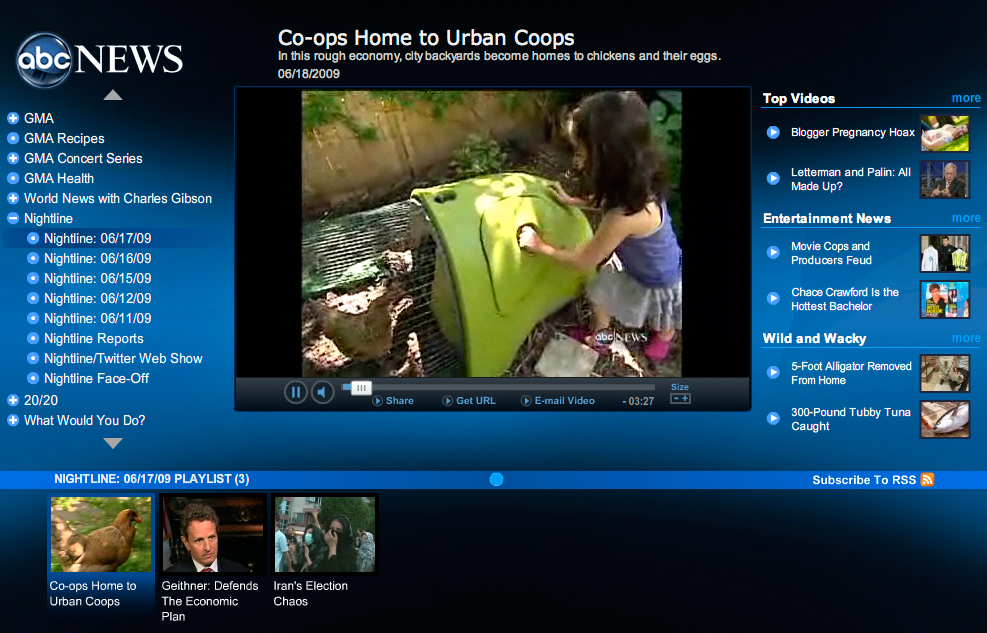Thought this was funny and wanted to share.
Author Archives: admin
Why You Should Not Keep Backyard Chickens
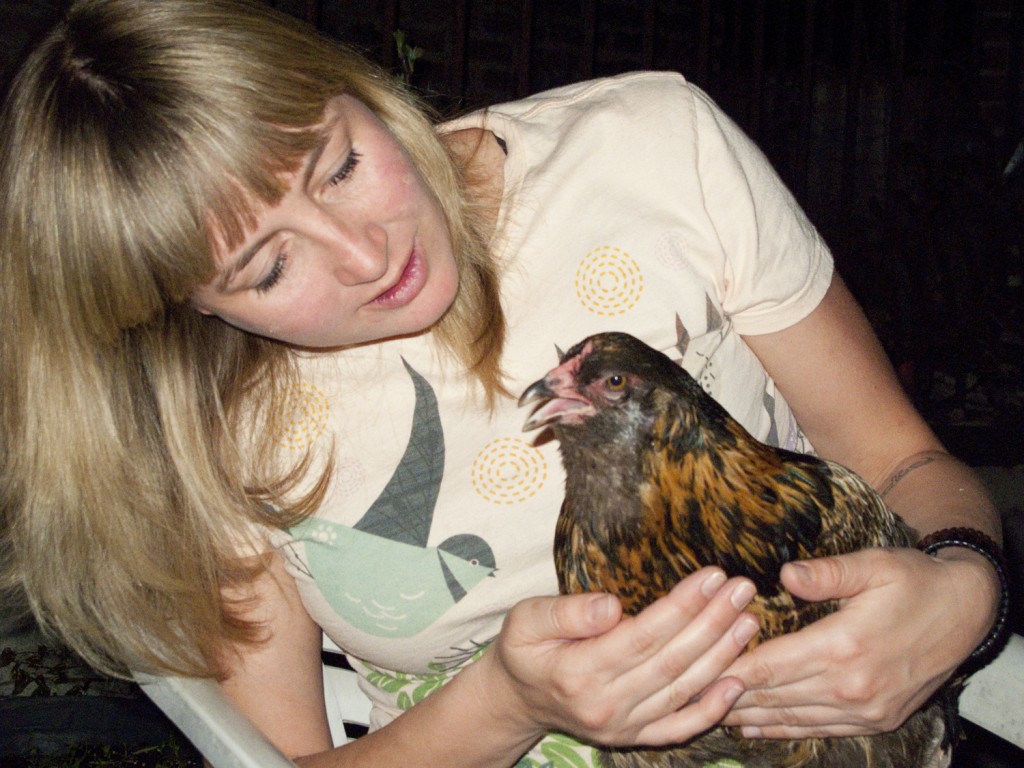 As I mentioned in an earlier post, I would recommend backyard chickens to almost anyone. Keeping chickens this past year has been a fun and educational experience for my whole family. We have brought our chickens to the local elementary school for their harvest fair and had our daughters pre-school class come to visit. Lots of friends have come over to see our set-up, and now two of them have chicks of their own.
As I mentioned in an earlier post, I would recommend backyard chickens to almost anyone. Keeping chickens this past year has been a fun and educational experience for my whole family. We have brought our chickens to the local elementary school for their harvest fair and had our daughters pre-school class come to visit. Lots of friends have come over to see our set-up, and now two of them have chicks of their own.
However, I don’t think backyard chickens are for everyone. Just like I don’t think dogs or cats are for everyone. Many people get animals thinking they are cute or fun or whatever and then realize that they are a lot of work. That is how so many animals end up abandoned or in shelters. So now I’m going to share the “down-side” of keeping chickens just to make sure that everyone knows what they are getting themselves into. Obviously these weren’t big enough cons to keep me from having chickens, but to some people they might be. I prefer that people know what they are getting themselves into rather than abandon or mistreat an animal.
- The cute fluffy chicks that arrive need an extreme amount of care and knowledge to keep them healthy. You need to keep them warm (but not too warm), you need to feed them special food, make sure their butts don’t paste up with droppings (fatal), make sure they don’t drown in their water dish, etc. etc. etc.
- Chicks are cute and fluffy for about 2 weeks. They start getting their feathers in in about a week and turn into very awkward looking teenagers. It’s amazing how quickly they look like chickens and not babies.
- Chickens are very social animals, so they need friends. In other words, you can’t just get one chicken or it will be depressed and lonely.
- Chickens don’t like being confined in a small space. They can get bored, which leads to gruesome acts such as feather picking (Where they pull feathers out of their companions). Ouch. Once they see blood, they pick even more, which can actually lead to cannibalism.
- Chickens need special diets for different stages of their lives. If they don’t get the proper, balanced nutrition they might have problems with feathers breaking off, or eggs coming out with soft shells (or no shells!)
- Chickens like to scratch and peck. If you let them out in your yard they will turn a small bare spot into a big, bare spot. They like to dig into the dirt and take dust baths.
- Chickens like to eat greens. That means not only grass, but also the lettuce you planted, the unripe blueberries you are waiting to eat, the ferns you just planted. You get the picture. They are like small goats. Almost anything is considered food.
- You need to check on your chickens every day. In the summer you need to make sure they have plenty of water and that they aren’t overheating. In the winter you need to make sure their water hasn’t frozen. In the rain you still need to check on them.
- Chickens like to eat chicken eggs also. If you don’t gather your eggs every day, the chicken might accidentally break one. As I mentioned above, chickens like to eat just about everything, so they will try the broken egg. That is the point where they decide they love the taste. You now have an egg-eater, who will deliberately break eggs to eat. When you go on vacation, you will need to find someone to gather eggs every day to prevent this from happening.
- Bird droppings smell. You will have to clean out the coop regularly to keep the ammonia from building up. Ammonia is bad for the birds to breathe and it is bad for us to smell. Droppings will attract flies and will repel your friends. Chickens can’t control their bowels like cats and dogs, so you could get hit at any time.
- Chickens are prone to getting parasites. Whether you introduce a new bird that has lice, or wild birds with mites fly into your yard, you will inevitably have to battle external parasites. I am in the middle of this battle and it is no fun! You have to scrub down the coop, spray or dust in every crevice and spray or dust your birds. I will make a post soon about this episode of our chickens lives. Parasites can kill your bird, so you have to deal with them. I just put my girls in a warm bath and cleaned the caked-on poop off their butt feathers yesterday. Make sure you are willing to do this! In case I’m not conveying how gross this is, you can see egg clusters around the base of feathers, scabs on your chickens butts and poop from the mites stuck in their feathers.
- Chickens lay eggs reliably for about 2-3 years. Chickens can live for about 10 years. What are you going to do with an old chicken that doesn’t lay anymore?
- Chickens are pretty delicate animals and can get sick. There are not many vets who take chickens. Are you willing/able to diagnose what’s wrong with your chicken? Will you be able to massage an egg out of your hen if it is stuck? Would you feed your chicken with an eye dropper if it stopped eating? Would you be able to humanely kill your chicken if it got mauled by a predator? Again, most vets won’t take chickens, even to put them down.
- Chickens need a safe and secure henhouse. You need to be able to keep your hens warm in the winter, cool in the summer. Animals such as raccoons, hawks, opossums, foxes and dogs should not be able to get into their run or coop.
- Chicken feed can attract rodents. I don’t think I need to elaborate on that one.
Have I lost you yet? Why would anyone be crazy enough to keep a chicken?? I think if you weighed many things in life you would find many cons to counter the pros. I can think of about 9,999 reasons not to have a baby, but I wouldn’t trade my kid for the world.
I love keeping chickens and to me they are more than worth any work they give me. Please make sure the same is true with you before you order some cute, fluffy chicks.
Pollinator Week in NYC
Today kicks off the 3rd National Pollinator Week and New York City beekeepers are campaigning to legalize beekeeping.
Things you can do during the week to show your support:
• You can click here to sign a petition to legalize beekeeping in NYC
• Go to the Beekeepers Ball on Monday 6/22 at Pier 17 (89 South Street) from 6pm-11pm. Click here for more info and tickets.
• Go to City Hall on June 23rd for a press conference and rally with other beekeepers and David Yassky. It will be held on the steps of City Hall at 12:30.
I’m having some technical difficulty, but when that is sorted out I will add a video of my friend Meg, who not only recently became a beekeeper, but has just ordered chicks for her backyard. Go Meg!!
The High Line in NYC

The decade-long project of Friends of the High Line (FHL) has just opened. The High Line was originally built in the 1930s as an elevated train track and went out of use in 1980. There were plans to tear down the elevated tracks, but a community-based non-profit group Friends of the High Line formed in 1999 to preserve it as a public space. The first section just opened a few days ago, which runs from Gansevoort Street to 20th Street. Eventually it will go to 34th Street and be a mile and a half long.
As you may know from previous posts, I love creative ideas for unwanted or underused spaces. This patch of green promises to be a soothing place in a very industrial area. I love that they are going to keep it a bit wild instead of having manicured plantings.
They are expecting big crowds, so they recommend that people enter at the corner of Gansevoort and Washington Streets. There are other exit/access points at 14th, 16th, 18th and 20th Streets. There is also an elevator at the 16th Street access point.
Hours: Open daily from 7am to 10pm.
You can see lots of photos and get more info at The High Line site.
City Nature Walks: Explore Nature in the Concrete Jungle
The Great Thing About Our Chickens
I love my backyard chickens for lots of different reasons. Here are a few:
1. They produce tasty eggs. Besides giving our chickens table scraps (lettuce, broccoli, fading fruit, etc.) we let them graze in our backyard. They eat a lot of grass and ivy (and just about anything that isn’t nailed down), which gives them added beta carotene. This in turn gives their yolks a rich, deep almost orange color. There is some debate as to whether pastured hens (those that eat a lot of grass instead of corn-based feed) lay eggs that are lower in cholesterol. All I know is that their eggs have a meaty taste that you don’t get with grocery store eggs.
2. They are funny and friendly. We raised our hens from chicks, so they are quite fond of us. Of course they are walking stomachs and I feed them, so I’m sure they love me for that too. When we sit out in our garden and they are roaming around, they often jump up into my lap for a little cuddle. Our silver-laced Polish Andie (with the big pom-pom hairdoo) has some trouble seeing because of the feathers in her face. She has to tilt her head to see things and sometimes she still bonks into furniture. It’s pretty funny to watch her.
3. They eat bugs. They dig and scratch in the dirt looking for bugs, but they are also hunters of mosquitoes and ticks. My girls don’t seem to be too interested in slugs, but I’ve heard that chickens like to eat slugs. That makes up for the garden nibbling they are prone to. My girls will grab a mosquito right off my leg for a snack. Love that!
4. They are educational. Lindsay has learned all about chickens. We also have lots of curious friends and neighbors come through with lots of questions. Probably the top two questions are: How can you get eggs without a rooster? (You can get eggs, but you can’t get fertilized eggs w/out a rooster) Do they smell? (They only smell if you don’t clean up after them. Much in the same way cats can smell if you don’t clean their litter box) We just had kids from Lindsay’s school come to meet the hens. Many had never touched a chicken before or seen a green or blue egg before.
5. They are a great ice breaker at parties. We live in Brooklyn and it is pretty unusual for people to keep chickens. People either think we’re cool or really weird. I can live with either of those.
6. They are great composters. As I mentioned above they eat all manner of kitchen scraps. We keep two tubs by our kitchen sink. One is the premier kitchen waste, which goes to the hens. The other goes into our compost bin. The chickens eat the scraps and poop out nitrogen-rich droppings. Their droppings go into the compost bin, which kick-starts the bin to really speed up the decomposition process. My garden is thriving with the added nitrogen.
Food scraps turn into compost and eggs. What a great system.
Gotham Greens
Check out this article in the New York Post. It is about the first commercial-scale hydroponic rooftop farm that will be started in Jamaica by a company called Gotham Greens, NY. They will get most of their power from solar panels, they will have a cistern to capture water and they will deliver their produce in a bio-diesel van. Great idea! There are so many flat rooftops in New York City that could become green roofs.
Our Chickens Debut on Nightline
The segment Co-ops Home to Urban Coops ran on Nightline last night. You can watch the segment here. I think the girls did a great job! They also showed the website My Pet Chicken, which is where we got our girls.
Chickens on Nightline 6/17
A couple of weeks ago a crew came from ABCs Nightline to talk to us about urban chicken keeping. They said that they would air the show tonight at 11:35. I hope I don’t look like the crazy chicken lady….
I’ll post a link to the segment when it’s on their website. That is, if I don’t look like too much of a dork.
The story of our urban chickens
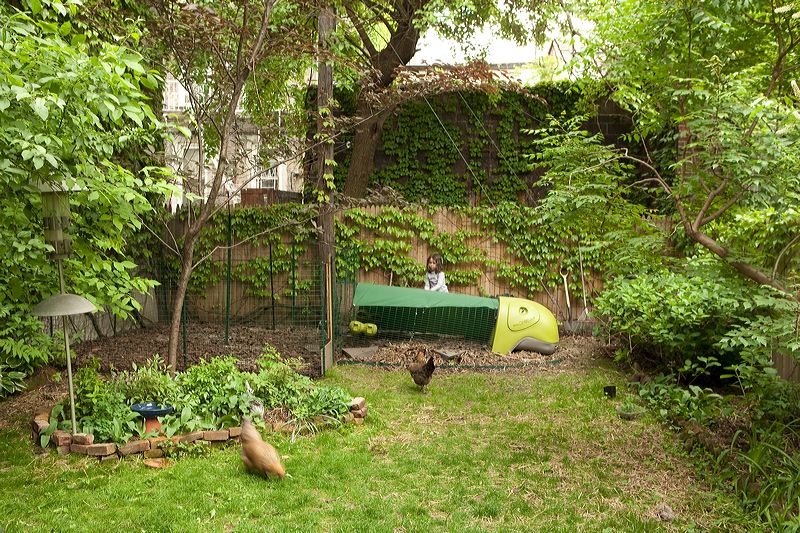
Almost a year ago my family decided to get chickens for our urban backyard. I thought I would write about our experiences because of the growing interest in backyard chicken-keeping.
After reading and researching and convincing my family, we ordered three day-old chicks to start our backyard flock. If you aren’t familiar with ordering livestock, it arrives via the United States Post.
Last July I got a call from my local post office saying that our chicks had arrived and in less than 10 minutes the mailman was at our door with a box emitting tiny peeping noises. I think he was happy to pass off this noisy box and get on with his regular, less-insistent packages!
Most hatcheries that sell mail-order chicks have a minimum order of 24 chicks. The large numbers of chicks in the box help keep them warm, which is crucial for the babies survival. These minimums are large enough that it prevents most hobbyists from ordering. Some people solve the problem by splitting their orders with friends. This is a great solution, but sometimes hard to coordinate. Mypetchicken.com stepped in to help urban chicken keepers. For people living in urban centers, they offer a minimum order of 3 chicks. They have special packaging that has a cushioning nest, green nutritious/hydrating gel and they include a heat pack if the weather is cool. Since my order came in July, they didn’t need to include the heat pack. Here’s a photo of my chicks when we opened the box.
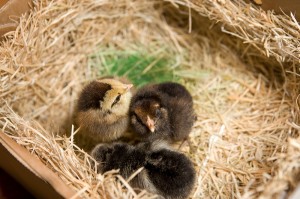
our 3 day-old chicks in the box they were mailed in
The chicks need some special care when they first arrive. They can be very stressed from the journey, and will need to have access to water immediately. You can gently dunk their beaks in their water dish to teach them where to find water. Also check their little butts to make sure they aren’t pasted up with droppings. The chicks need to be kept in a special place called a brooder that is warm and away from drafts. You should have the brooder already set up for their arrival. The brooder can be an old aquarium, cardboard box, Rubbermaid tub…you get the idea. I made mine out of an old hamster cage and put cardboard around the sides to protect from drafts and paper towels on the bottom to keep them from slipping on the plastic. I bought a heat lamp from my local hardware store.
To feed them you will need chick crumbles and fresh water (very shallow, so they can’t fall in and drown). They need to be warm. A guideline is 90-100ºF the first week and then 5ºF less each week. Check on how they act . If they are panting and huddling away from the heat source, it’s too hot. If they are mashed together in a ball under the light, it’s too cold. Take a peek at backyard chickens for more detailed instructions on raising your chicks during their first 60 days.
The chicks sleep a lot and will sometimes just sort of fall over. This can be a little disturbing to a newbie because it looks as though they’ve just keeled over.
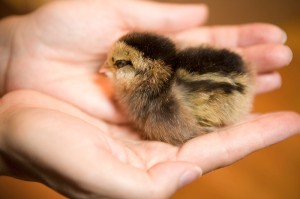
This little one is Edie. She’s the sweetest of the group. On her first day I held her for a few seconds and she drifted off to sleep in my hands. She’s what’s known as an Easter Egger chick, which is a mixed breed derived from the Araucana chicken. Easter Eggers aren’t a pure breed, but they have the same blue-green colored eggs of Araucanas.
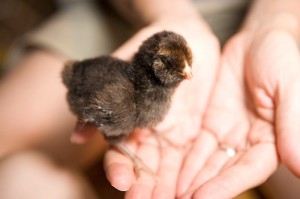
Louise or LouLou for short
This little pee-wee is LouLou and she’s an Easter Egger also. There is a huge variation of coloring with Easter Eggers. Interestingly enough, their coloring as chicks may bear little resemblance to their adult coloring. LouLou is the loudmouth, bratty little sister of the group. When her sisters are asleep, she chirps her head off to wake them up. I don’t know if her motivation stems from loneliness or sadism, but she’s got quite a personality. Despite her size, I’m putting my money on her to be the top of the pecking order.
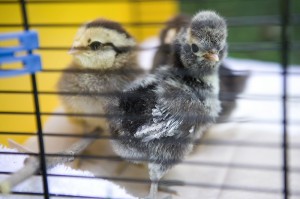
Andie and gang at 4 days
The gray one is Andie. She is a silver laced polish chick and will look like this when she grows up. The big pompom “hairdoo” she will get reminded us of Andy Warhol’s hair, so we kind of went with a theme of Andy Warhol’s Factory. LouLou is named for Lou Reed. Edie is for Edie Sedgwick and of course Andie is Andy Warhol. We joke that we have factory eggs, although these gals will be the farthest from factory hens you can imagine.
4 Days Old:
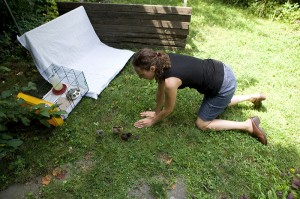
the chicks outside of their brooder for the first time
The rate of the chicks growth is amazing. Since the weather outside was as hot as their brooder, we decided to take them outside for a photo shoot. We put a blanket down to make a little photo sweep backdrop and put down our picnic table and brooder to try and keep them somewhat contained. They were pretty freaked out after my bumping them down our spiral staircase to the outside and kept very close to me. I think they see me as mama hen, which warms my little heart.
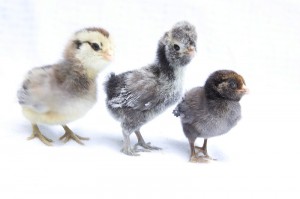
Edie, Andie and LouLou
You can get a pretty good idea of their respective sizes. LouLou is a little crouched down, but she’s definitely the smallest of the bunch. What she lacks in size, she makes up for in pushiness. You can see the tips of wing feathers starting to come in on Andie.
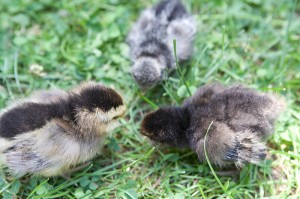
Once the girls got used to their new surroundings, they really started enjoying themselves. They had a blast pecking at the grass and scratching around on the ground. We’re going to take them outside for a few minutes each day to let them get used to the outdoors.
10 Days Old:
It’s been fascinating to watch the changes the chicks have already gone through. In their second week they have tripled in size, started to scratch the ground and learned to fly about 2 feet off the ground. They have quite a lot of feathers on their wings and have started to get silly little tail feathers. They start to look really mangy when their true feathers start peeking out of their baby fluff. It will be pretty hilarious to see how scruffy they look when the feathers on their necks and faces start to come in.
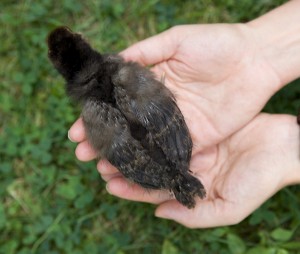
LouLou getting wing and tail feathers
LouLou has overtaken Andie in size and is still my bet for dominant hen. I’m crossing my fingers that she doesn’t end up being a rooster. I paid extra to get “sexed chicks” because roosters are illegal in NYC. There’s actually a job where someone looks at day-old chicks and determines their sex. They have a 90% accuracy rate. I read on a chicken forum the saying, “if it lays it stays and if it crows it goes”, which will certainly hold true here. I’m crossing my fingers that we have all girls because I’ve grown so attached to them.
Okay, now that I’ve just admitted I read chicken forums (or chicken porn as my husband refers to my late-night internet chicken research), I will attempt to distract you with cute chick photos…
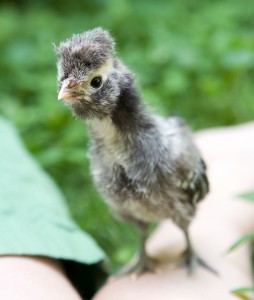
Andie looking like an ostrich
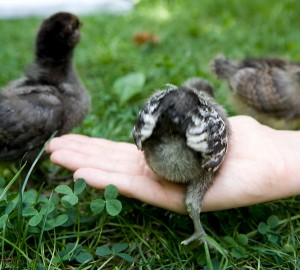
fuzzy butt
3 Weeks Old:
We’re going to stay at my in-law’s home in the Berkshires and are bringing the chicks with us. They are almost 2 weeks old and we’ve upgraded to a dog crate to accommodate for their exponential growth. We’ve nicknamed our minivan “gypsy” because we are now traveling with livestock. I guess goats will be next!
In the meantime, take a peek at some beautiful pen and ink drawings of chicks growing up by Kip Mieke Roth.
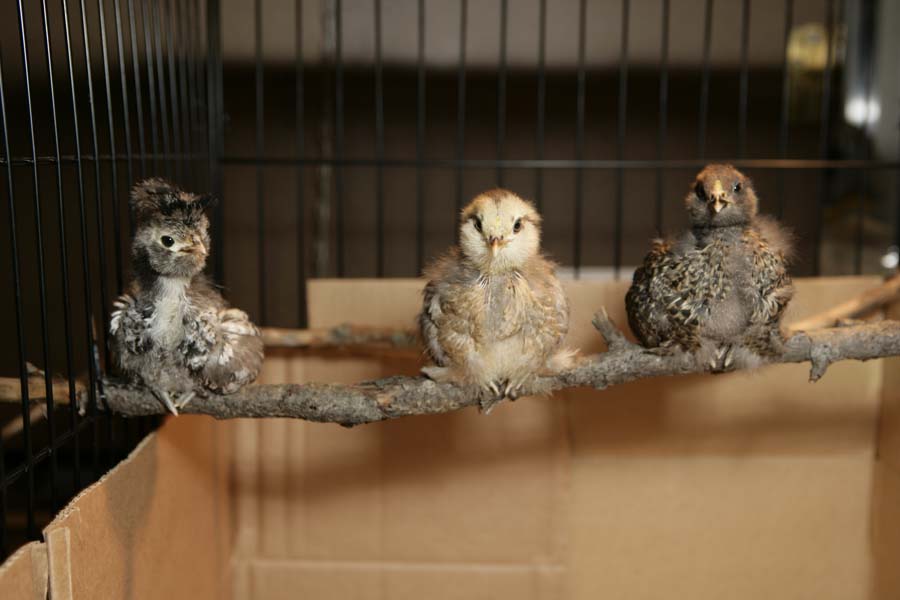
We found a nice stick to use as a perch on one of our nature hikes in the Berkshires. They immediately hopped on and now sleep on their perches. At 3 weeks, they have a lot of feathers, but still need the heat lamp until their feathers have filled in a bit more. I only turn it on at night when the temperature drops. The cardboard around the bottom of their cage isn’t so much for drafts as it is to keep the mess down. Chickens love to scratch! These girls dig and scratch and kick around in their pine shaving bedding and have a grand old time. The mess they make with the shavings is pretty impressive, and since we’re staying at someone else’s house, I want to do my best to keep the mess down. They look less like chickens to me and more like owls or some sort of forest creature. Andie is sporting a very ratty looking mohawk.
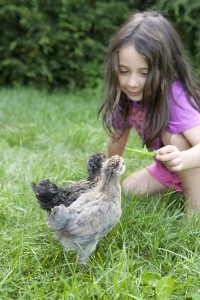
Lindsay playing with the girls
Our daughter Lindsay is really enjoying the chicks. She is 4 years old and is very gentle with them. I’m less worried now that they have grown so much in size. LouLou is on the left and Edie is on the right. They have gotten most of their feathers in the days between 2 and 3 weeks. They enjoy munching on grass and eating the mosquitoes that I smack on my legs and hand to them. Gotta give them a taste for those buggers!
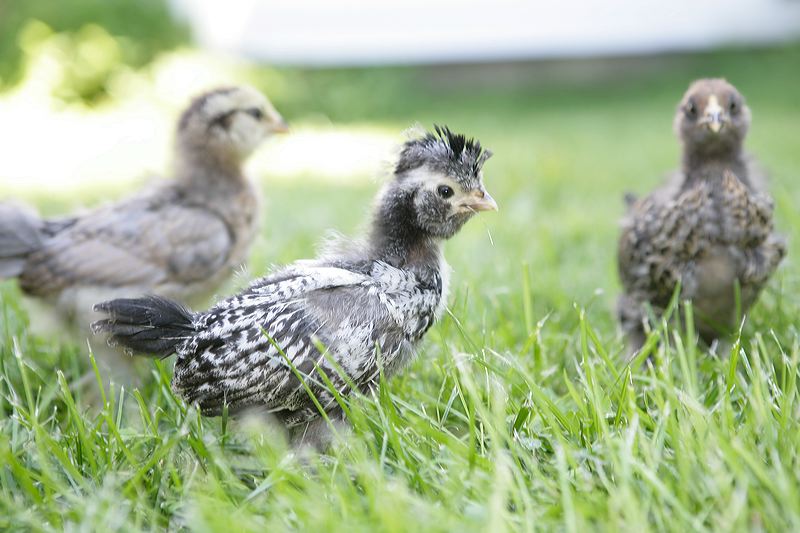
6 Weeks Old:
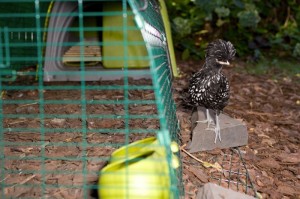
Andie next to the coop
The coop arrived a few weeks ago and the girls are now used to living outdoors. We ordered The Eglu by Omlet, which is probably one of the fanciest coops on the market. Part of the stipulation (from my once-skeptical husband) of getting chickens was that our backyard shouldn’t look like a run-down barnyard. The Eglu looks a bit like the old IMacs, is predator proof (we have raccoons and hawks here in Brooklyn) and easy to clean. You can see their water bowls in the foreground of the wire run and the perches through the (close-able) door to the insulated coop.
The first photo shows Andie with her increasingly crazy hair-doo outside the coop for a little free-ranging. Chickens are omnivores and love a varied diet. They love all kinds of insects, slugs and mosquitoes, which give them protein. They also love to eat grass and plants, which provide them with a rich source of beta-carotene that the mostly corn-fed factory chickens don’t get. The yolks of grass-fed chickens are a much deeper, richer yellow than we are used to getting from the grocery stores here. In Europe, the grocery store eggs still have quite orange yolks. My girls haven’t started producing eggs yet. I expect that will happen around Christmas/The New Year.
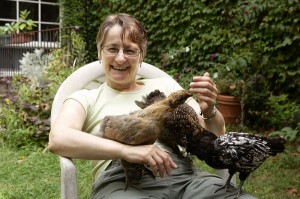
my friend Ruth with the girls
This photo shows my friend Ruth the chick magnet. It really shows how curious and friendly the chicks are. They have been used to being around people, so they flock around us whenever they are out of their coop. They still make cheep cheep sounds, although we get the occasional bwock sound.
9 Weeks Old:

Edie with a beard
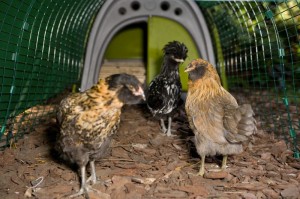
LouLou, Andie and Edie
We got back from a visit to my father in France to discover some of our girls grew beards! Edie, pictured above was the little one who looked like a chipmunk originally. LouLou has grown orange and brown feathers in place of her all-dark baby fluff, and Andie has spectacular black and white feathers and a crazy pompom hairdoo now.
29 Weeks Old:
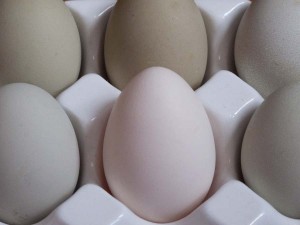
first eggs
We can now fast-forward a bit to when the girls started to lay. LouLou was the first to lay an egg (on Groundhog’s Day) and you can catch up with that in my post here. You can tell when your chicks are about to get ready to lay when their combs turn red. You can see in the photo of Edie above that her comb hasn’t really developed and is quite pale. I can tell which hen laid which egg because each one is a slightly different color. LouLou’s are sage green, Edie’s are a pale blue and Andie’s are white.
We have enjoyed our chickens tremendously and highly recommend chicken keeping to almost anyone. We felt like first-time parents as we watched our chicks grow into hens. We love the rich, “meaty” eggs they give us. How many people have pets that make them breakfast?? What was really important to us was that our “city girl” daughter would grow up knowing where her food comes from, and now she does.
I will write more about the nuts and bolts of keeping city chickens in my next post.


